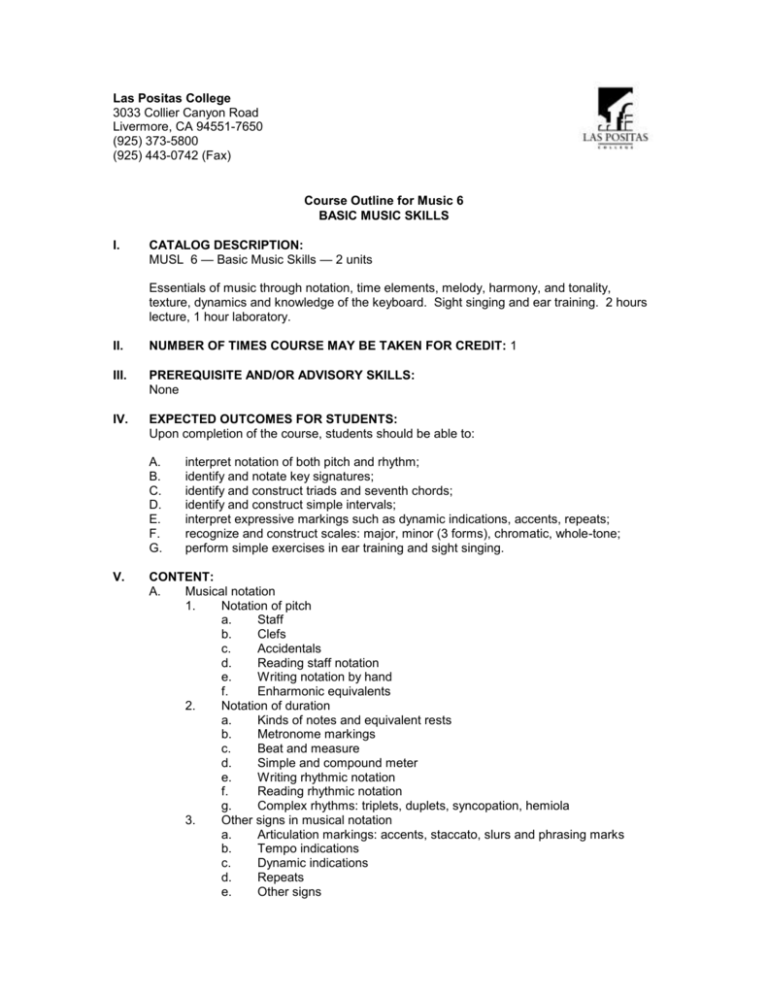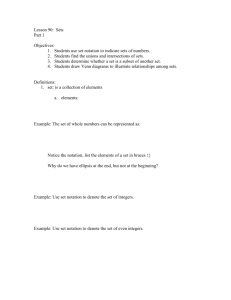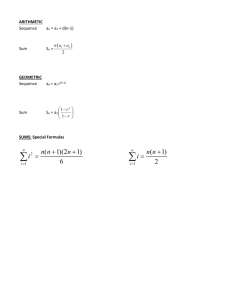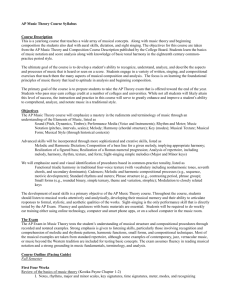Basic Music Skills - Las Positas College
advertisement

Las Positas College 3033 Collier Canyon Road Livermore, CA 94551-7650 (925) 373-5800 (925) 443-0742 (Fax) Course Outline for Music 6 BASIC MUSIC SKILLS I. CATALOG DESCRIPTION: MUSL 6 — Basic Music Skills — 2 units Essentials of music through notation, time elements, melody, harmony, and tonality, texture, dynamics and knowledge of the keyboard. Sight singing and ear training. 2 hours lecture, 1 hour laboratory. II. NUMBER OF TIMES COURSE MAY BE TAKEN FOR CREDIT: 1 III. PREREQUISITE AND/OR ADVISORY SKILLS: None IV. EXPECTED OUTCOMES FOR STUDENTS: Upon completion of the course, students should be able to: A. B. C. D. E. F. G. V. interpret notation of both pitch and rhythm; identify and notate key signatures; identify and construct triads and seventh chords; identify and construct simple intervals; interpret expressive markings such as dynamic indications, accents, repeats; recognize and construct scales: major, minor (3 forms), chromatic, whole-tone; perform simple exercises in ear training and sight singing. CONTENT: A. Musical notation 1. Notation of pitch a. Staff b. Clefs c. Accidentals d. Reading staff notation e. Writing notation by hand f. Enharmonic equivalents 2. Notation of duration a. Kinds of notes and equivalent rests b. Metronome markings c. Beat and measure d. Simple and compound meter e. Writing rhythmic notation f. Reading rhythmic notation g. Complex rhythms: triplets, duplets, syncopation, hemiola 3. Other signs in musical notation a. Articulation markings: accents, staccato, slurs and phrasing marks b. Tempo indications c. Dynamic indications d. Repeats e. Other signs Course Outline for Music 6 Page 2 BASIC MUSIC SKILLS B. C. D. E. F. G. H. Major and minor key signatures 1. Identifying key signatures 2. Notating key signatures Scales: identification and construction 1. Major 2. Minor: natural, harmonic, melodic 3. Chromatic 4. Whole tone Harmony 1. Triads and inversions 2. Seventh chords and inversions 3. chord progressions 4. Identification of harmony in musical context Intervals: number and quality 1. Identification 2. Construction Ear training 1. Intervals 2. Triads 3. Melodic dictation 4. Rhythmic dictation Sight singing 1. Solfegg 2. Numbers 3. Other methods Analysis 1. Harmony 2. Form VI. METHODS OF INSTRUCTION: A. Lecture-demonstration of concepts B. Small group and whole class discussion C. Written practice exercises D. Class participation through tapping and counting rhythms, singing and/or playing instruments to respond to musical notation E. Class and individual basic musical analysis F. Individual compositional experimentation and performance VII. TYPICAL ASSIGNMENTS: A. In reading: 1. Read Chapter IV, “Reading Rhythm” in Windows on Music in preparation for counting exercises in class. 2. Read chapter 1 in Windows on Music and do computer activity 3 on page 6. B. In writing, listening, problem solving/critical thinking: 1. Identify the major, minor, perfect, augmented and diminished intervals on the worksheet. 2. change each major scale on the worksheet to harmonic minor. 3. Analyze the folk song and identify the harmony in each measure. VIII. EVALUATION: A. Methods: typical examples of evaluation 1. Quizzes – 10 per semester a. Typical questions: i. Add the sharps or flats necessary to make this a D Major Scale ii. Notate a chromatic scale from G to D, ascending and descending. Course Outline for Music 6 Page 3 BASIC MUSIC SKILLS Rhythm quizzes – 10 per semester a. Typical task: Be prepared to clap and count the rhythms in lines 2-6 on the handout. 3. Examinations: Mid-term and final a. Typical questions: i. Fill in the blanks on the circle of fifths. Indicated major and minor keys, the number of sharps or flats in each, and the order of sharps and flats. ii. Notate the C# Melodic Minor scale, ascending and descending, on the staff below. Use a key signature and accidentals as necessary. 4. Individual project:: a. Compose an eight measure melody. Choose a key and meter for your composition. End on the keynote. b. Add a chordal accompaniment to your melody. 5. Ear training quizzes a. Typical questions: iii. Circle the interval that you hear. i. Major 3rd ii. Minor 3rd iv. Circle the triad that you hear. i. Major triad, first inversion ii. Diminished triad Frequency 1. Written quizzes – 10 per semester 2. Rhythm quizzes – 10 per semester 3. Ear training quizzes – 5 per semester 4. One individual project 5. One mid-term examination 6. Final examination 2. B. IX. TYPICAL TEXTS: A. Evans, Jeffrey, Windows on Music: Learning with Practica Musica, Third Edition. Kirkland, Washington: Ars Nova Software, 1996 B. Lynn, Theodore, A., Introductory Musicianship, Fifth Edition. Fort Worth, Texas: Harcourt Brace college Publishers, 1997 C. White, Gary, Music First!, Second Edition. Madison, Wisconsin: Brown & Benchmark, 1993 D. Duckworth, Wiliam. A Creative Approach to Music Fundamentals, Sixth Edition. Belmont, California: Wadsworth Publishing Company, 1998 X. OTHER MATERIALS REQUIRED OF STUDENTS: Staff paper Ear phones Creation Date: Revision Date: Musl6.doc 1/01








